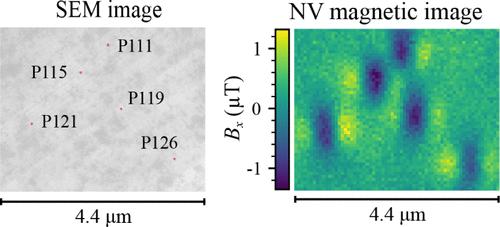超顺磁性氧化铁纳米颗粒的时间分辨金刚石磁显微镜
IF 16
1区 材料科学
Q1 CHEMISTRY, MULTIDISCIPLINARY
引用次数: 0
摘要
超顺磁性氧化铁纳米粒子(SPIONs)是一种很有前途的生物医学成像探针,但其磁性的非均质性难以用现有方法表征。在这里,我们使用基于金刚石中氮空位中心的磁显微镜对数百个隔离的~ 30 nm SPIONs产生的杂散磁场进行了宽场成像。通过分析SPION磁场模式作为外加磁场的函数,我们观察到大量与场相关的横向磁化分量,这些分量通常被系综表征方法所掩盖。我们发现,在我们的样品中几乎所有的SPIONs的三个磁化分量中,每一个磁化分量的磁滞都可以忽略不计。大多数spion表现出尖锐的朗之万饱和曲线,由特征极化场Bc列举。Bc分布高度不对称,标准差(σc = 1.4 mT)大于中位数(0.6 mT)。使用时间分辨磁显微镜,我们直接记录了SPION nsamel弛豫,在关闭31mt的外加磁场后,时间分辨率为~ 60ms,这是受电磁体线圈衰缩时间的限制。对于小偏置场|Bhold| = 1.5-3.5 mT,我们观察到SPION nsamel弛豫时间范围很广——从毫秒到秒——这与Bhold的指数依赖性是一致的。我们的时间分辨金刚石磁显微镜研究揭示了丰富的SPION样品非均质性,并可能扩展到其他纳米磁性的基础研究。本文章由计算机程序翻译,如有差异,请以英文原文为准。

Time-Resolved Diamond Magnetic Microscopy of Superparamagnetic Iron-Oxide Nanoparticles
Superparamagnetic iron-oxide nanoparticles (SPIONs) are promising probes for biomedical imaging, but the heterogeneity of their magnetic properties is difficult to characterize with existing methods. Here, we perform wide-field imaging of the stray magnetic fields produced by hundreds of isolated ∼30 nm SPIONs using a magnetic microscope based on nitrogen-vacancy centers in diamond. By analyzing the SPION magnetic field patterns as a function of the applied magnetic field, we observe substantial field-dependent transverse magnetization components that are typically obscured with ensemble characterization methods. We found negligible hysteresis in each of the three magnetization components for nearly all SPIONs in our sample. Most SPIONs exhibit a sharp Langevin saturation curve, enumerated by a characteristic polarizing applied field, Bc. The Bc distribution is highly asymmetric, with a standard deviation (σc = 1.4 mT) that is larger than the median (0.6 mT). Using time-resolved magnetic microscopy, we directly record SPION Néel relaxation, after switching off a 31 mT applied field, with a temporal resolution of ∼60 ms, which is limited by the ring-down time of the electromagnet coils. For small bias fields |Bhold| = 1.5–3.5 mT, we observe a broad range of SPION Néel relaxation times – from milliseconds to seconds – that are consistent with an exponential dependence on Bhold. Our time-resolved diamond magnetic microscopy study reveals rich SPION sample heterogeneity and may be extended to other fundamental studies of nanomagnetism.
求助全文
通过发布文献求助,成功后即可免费获取论文全文。
去求助
来源期刊

ACS Nano
工程技术-材料科学:综合
CiteScore
26.00
自引率
4.10%
发文量
1627
审稿时长
1.7 months
期刊介绍:
ACS Nano, published monthly, serves as an international forum for comprehensive articles on nanoscience and nanotechnology research at the intersections of chemistry, biology, materials science, physics, and engineering. The journal fosters communication among scientists in these communities, facilitating collaboration, new research opportunities, and advancements through discoveries. ACS Nano covers synthesis, assembly, characterization, theory, and simulation of nanostructures, nanobiotechnology, nanofabrication, methods and tools for nanoscience and nanotechnology, and self- and directed-assembly. Alongside original research articles, it offers thorough reviews, perspectives on cutting-edge research, and discussions envisioning the future of nanoscience and nanotechnology.
 求助内容:
求助内容: 应助结果提醒方式:
应助结果提醒方式:


